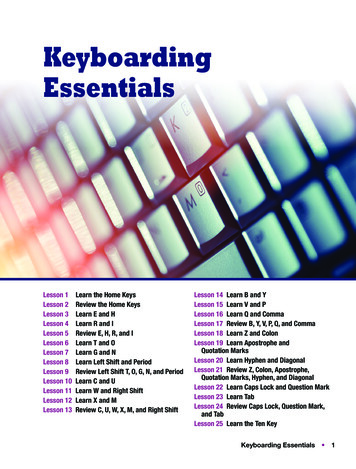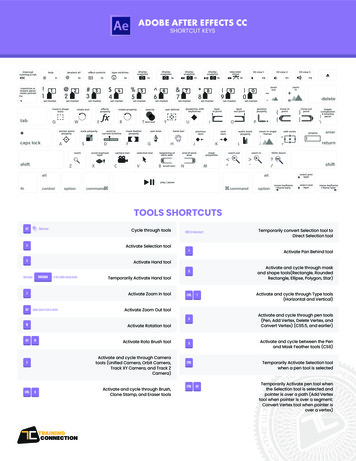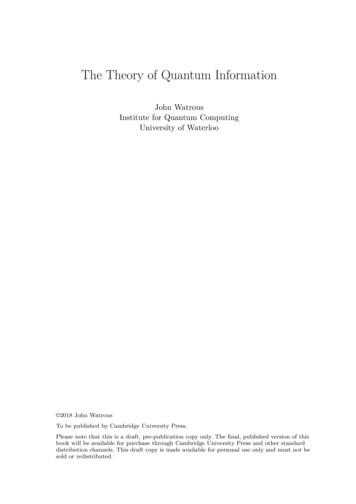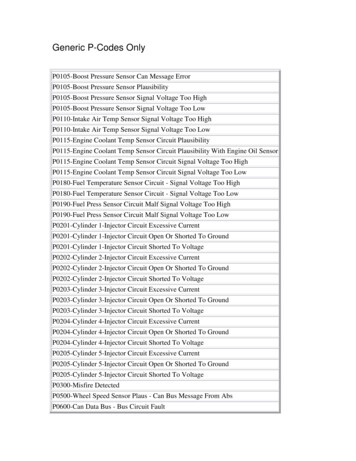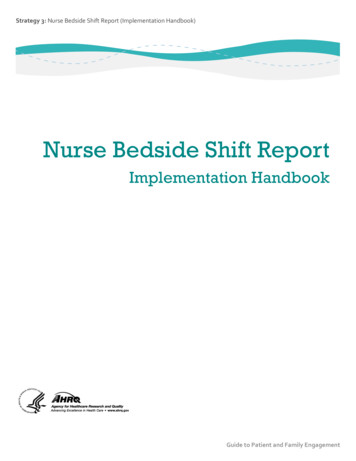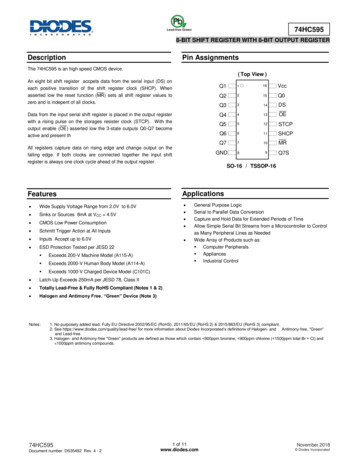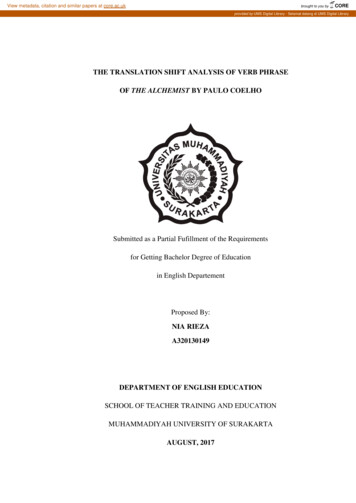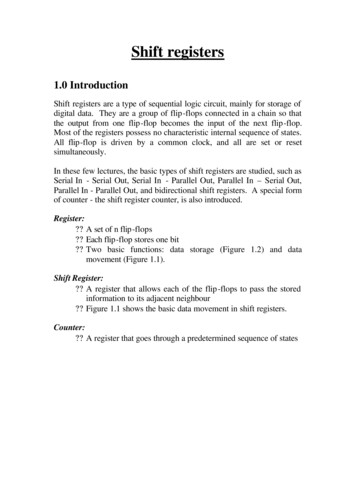
Transcription
Shift registers1.0 IntroductionShift registers are a type of sequential logic circuit, mainly for storage ofdigital data. They are a group of flip-flops connected in a chain so thatthe output from one flip-flop becomes the input of the next flip-flop.Most of the registers possess no characteristic internal sequence of states.All flip-flop is driven by a common clock, and all are set or resetsimultaneously.In these few lectures, the basic types of shift registers are studied, such asSerial In - Serial Out, Serial In - Parallel Out, Parallel In – Serial Out,Parallel In - Parallel Out, and bidirectional shift registers. A special formof counter - the shift register counter, is also introduced.Register:? A set of n flip-flops? Each flip-flop stores one bit? Two basic functions: data storage (Figure 1.2) and datamovement (Figure 1.1).Shift Register:? A register that allows each of the flip-flops to pass the storedinformation to its adjacent neighbour? Figure 1.1 shows the basic data movement in shift registers.Counter:? A register that goes through a predetermined sequence of states
Figure 1.1: Basic data movement in shift registers [Floyd]Storage Capacity:The storage capacity of a register is the total number of bits (1 or 0) ofdigital data it can retain. Each stage (flip flop) in a shift registerrepresents one bit of storage capacity. Therefore the number of stages in aregister determines its storage capacity.Figure 1.2: The flip-flop as a storage element.
2.0 Serial In - Serial Out Shift RegistersThe serial in/serial out shift register accepts data serially – that is, one bitat a time on a single line. It produces the stored information on its outputalso in serial form.2.1 Example: Basic four-bit shift registerFigure 2.1A basic four-bit shift register can be constructed using four D flip-flops,as shown in Figure 2.1.The operation of the circuit is as follows.? The register is first cleared, forcing all four outputs to zero.? The input data is then applied sequentially to the D input of thefirst flip-flop on the left (FF0).? During each clock pulse, one bit is transmitted from left to right.? Assume a data word to be 1001.? The least significant bit of the data has to be shifted through theregister from FF0 to FF3.
In order to get the data out of the register, they must be shifted outserially. This can be done destructively or non-destructively. Fordestructive readout, the original data is lost and at the end of the readcycle, all flip-flops are reset to zero.FF00FF10FF20FF301001The data is loaded to the register when the control line is HIGH (ieWRITE). The data can be shifted out of the register when the control lineis LOW (ie F2FF301READ:FF2FF301FF3000001001
Figure 2.2 illustrates entry of the four bits 1010 into the register. Figure2.3 shows the four bits (1010) being serially shifted out of the register andreplaced by all zeros.Figure 2.2: Four bits (1010) being entered serially into the register.
Figure 2.3: Four bits (1010) being serially shifted out of the register and replacedby all zeros
2.2 5-bit serial in/serial out shift registersFigure 2.4 illustrates entry of the five bits 11010 into the register.Figure 2.4
3.0 Serial In - Parallel Out Shift RegistersFor this kind of register, data bits are entered serially in the same manneras discussed in the last section. The difference is the way in which thedata bits are taken out of the register. Once the data are stored, each bitappears on its respective output line, and all bits are availablesimultaneously. A construction of a four-bit serial in - parallel out registeris shown below.In the table below, we can see how the four-bit binary number 1001 isshifted to the Q outputs of the register.Clear1001FF001001FF100100FF200010FF300001
3.1 An 8-bit serial in/parallel out shift register (74HC164)The 74HC164 is an example of an IC shift register having serialin/parallel out operation. The logic diagram and logic block are shown inFigure 3.1 (a),(b).Figure 3.1: The logic diagram and logic block of 74HC164Figure 3.2: The timing diagram of 74HC164
4.0 Parallel In - Serial Out Shift RegistersA four-bit parallel in - serial out shift register is shown below. Thecircuit uses D flip-flops and NAND gates for entering data (ie writing) tothe register.D0, D1, D2 and D3 are the parallel inputs, where D0 is the mostsignificant bit and D3 is the least significant bit. To write data in, themode control line is taken to LOW and the data is clocked in. The datacan be shifted when the mode control line is HIGH as SHIFT is activehigh. The register performs right shift operation on the application of aclock pulse, as shown in the table 01100111010011001
4.1 8-bit Parallel Load Shift Register (74HC165)The 74HC165 is an example of an IC shift register that has a parallelin/serial out operation. It can also be operated as serial in/serial out.Figure 4.1 shows the logic diagram and logic symbol of 74HC165.Figure 4.1: the logic diagram and logic symbol of 74HC165.
Figure 4.2: The timing diagram of 74HC165.
5.0 Parallel In - Parallel Out Shift RegistersFor parallel in - parallel out shift registers, all data bits appear on theparallel outputs immediately following the simultaneous entry of the databits. The following circuit is a four-bit parallel in - parallel out shiftregister constructed by D flip-flops.Figure 5.1The D's are the parallel inputs and the Q's are the parallel outputs. Oncethe register is clocked, all the data at the D inputs appear at thecorresponding Q outputs simultaneously.5.1 4-bit Parallel-Access Shift Register (74HC195)The 74HC195 can be used for parallel in/parallel out operation, serialin/serial out and serial in/parallel out operations. Q3 is the output when itis used for parallel in/serial out operation.Figure 5.2: The 74LS195A 4-bit parallel access shift register
Figure 5.3: The timing diagram for 74LS195A shift register
6.0 Bidirectional Shift RegistersThe registers discussed so far involved only right shift operations. Eachright shift operation has the effect of successively dividing the binarynumber by two. If the operation is reversed (left shift), this has the effectof multiplying the number by two. With suitable gating arrangement aserial shift register can perform both operations.A bidirectional, or reversible, shift register is one in which the data can beshift either left or right. A four-bit bidirectional shift register using Dflip-flops is shown below.Here a set of NAND gates are configured as OR gates to select datainputs from the right or left adjacent bistables, as selected by theLEFT/RIGHT control line.Alternative Circuit:[Floyd]
6.1 4-Bit Bidirectional Universal Shift Registers (74HC194)The 74HC194 is a universal bi-directional shift register. It has both serialand parallel input and output capability.[Floyd]Figure 6.1:The 74HC194 4-bit bi-directional universal shift registerFigure 6.2:The timing diagram of 74HC194
7.0 Shift Register CountersTwo of the most common types of shift register counters are introducedhere: the Ring counter and the Johnson counter. They are basically shiftregisters with the serial outputs connected back to the serial inputs inorder to produce particular sequences. These registers are classified ascounters because they exhibit a specified sequence of states.7.1 Ring CountersA ring counter is basically a circulating shift register in which the outputof the most significant stage is fed back to the input of the leastsignificant stage. The following is a 4-bit ring counter constructed fromD flip-flops. The output of each stage is shifted into the next stage on thepositive edge of a clock pulse. If the CLEAR signal is high, all the flipflops except the first one FF0 are reset to 0. FF0 is preset to 1 instead.Since the count sequence has 4 distinct states, the counter can beconsidered as a mod-4 counter. Only 4 of the maximum 16 states areused, making ring counters very inefficient in terms of state usage. Butthe major advantage of a ring counter over a binary counter is that it isself-decoding. No extra decoding circuit is needed to determine whatstate the counter is in.
7.1.1 Example: A 10-bit Ring Counter [Flyod]Figure 7.1: 10-bit ring counter & its sequenceFigure 7.2: 10-bit ring counter waveform (initial state 1010000000)
7.2 Johnson CountersJohnson counters are a variation of standard ring counters, with theinverted output of the last stage fed back to the input of the first stage.They are also known as twisted ring counters. An n-stage Johnsoncounter yields a count sequence of length 2n, so it may be considered tobe a mod-2n counter. The circuit below shows a 4-bit Johnson counter.The state sequence for the counter is given in the table .?Again, the apparent disadvantage of this counter is that the maximumavailable states are not fully utilized. Only eight of the sixteen statesare being used.?Beware that for both the Ring and the Johnson counter must initiallybe forced into a valid state in the count sequence because they operateon a subset of the available number of states. Otherwise, the idealsequence will not be followed.
7.2.1 Example: 5 bit Johnson Counter [Flyod]Figure 7.3: 5-bit Johnson Counter, its sequence and waveform
8.0 ApplicationsShift registers can be found in many applications. Here is a list of a few.? To produce time delayThe serial in -serial out shift register can be used as a time delay device.The amount of delay can be controlled by:1. the number of stages in the register2. the clock frequencyFigure 8.1: The shift register as a time-delay device.? To simplify combinational logicThe ring counter technique can be effectively utilized to implementsynchronous sequential circuits. A major problem in the realization ofsequential circuits is the assignment of binary codes to the internal statesof the circuit in order to reduce the complexity of circuits required. Byassigning one flip-flop to one internal state, it is possible to simplify thecombinational logic required to realize the complete sequential circuit.When the circuit is in a particular state, the flip-flop corresponding to thatstate is set to HIGH and all other flip-flops remain LOW.
? To convert serial data to parallel dataA computer or microprocessor-based system commonly requiresincoming data to be in parallel format. But frequently, these systemsmust communicate with external devices that send or receive serial data.So, serial-to-parallel conversion is required. As shown in the previoussections, a serial in - parallel out register can achieve this.Figure 8.2: Simplified logic diagram of a serial-to-parallel converter
To write data in, the mode control line is taken to LOW and the data is clocked in. The data can be shifted when the mode control line is HIGH as SHIFT is active high. The register performs right shift operation on the application of a clock pulse, as shown in the table below. Q 0 Q 1 Q 2 Q 3 Clear 0 0 0 0 Write 1 0 0 1 Shift 1 0 0 1
